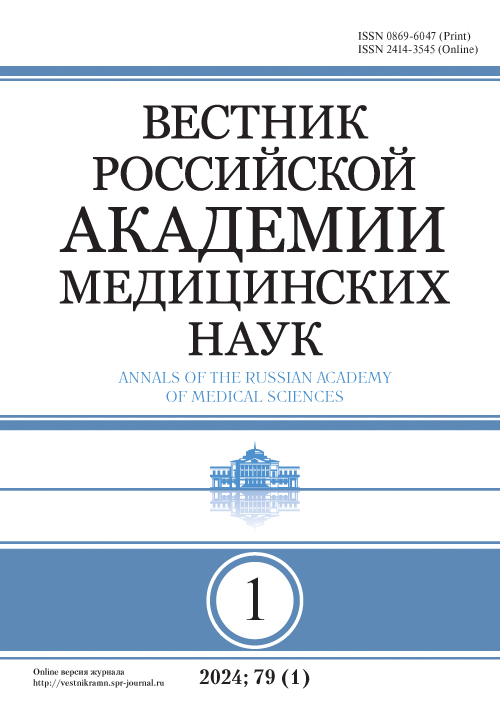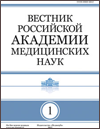The Effect of the Antioxidant Drug U-74389G on Magnesium Levels During Hypoxia–Reoxygenation Injury in Rats
- Authors: Τsompos C.1, Panoulis C.2, Τοutouzas K.2, Ζografos G.2, Papalois A.3
-
Affiliations:
- Mesologi County Hospital
- Aretaieion Hospital, Athens University
- Exprerimental Research Center ELPEN Pharmaceuticals, S.A. Inc., Co.
- Issue: Vol 70, No 4 (2015)
- Pages: 408-412
- Section: PHYSIOLOGY: CURRENT ISSUES
- URL: https://vestnikramn.spr-journal.ru/jour/article/view/487
- DOI: https://doi.org/10.15690/vramn.v70.i4.1405
- ID: 487
Cite item
Abstract
Objective: The aim of this experimental study was to examine the effect of the antioxidant drug U-74389G in a rat model of hypoxia – reoxygenation using the previously established protocol. Effects of treatments were evaluated by magnesium (Mg2+) levels in blood.
Methods: Nonrandomized controlled study was performed. Mg2+ levels were determined in 60 min (groups A and C) and 120 min (groups B and D) after starting the reoxygenation. Groups A and B received no drugs, whereas rats from groups C and D were administered with U-74389G.
Results: 40 rats 16–18 weeks old of a mean weight of 2312 g were employed in the study. It is demonstrated that U-74389G administration did not alter the Mg2+ levels (decrease in Mg2+ concentration was 0.28±2.75%; p =0.917). Reoxygenation non-significantly increased the Mg2+ levels by 4.27±2.66% (p =0.107). Together, the U-74389G administration and reoxygenation non-significantly increased the Mg2+ levels by 0.36±1.64% (p =0.823).
Conclusion: U-74389G administration, alone or in concert with reoxygenation did not significantly affect Mg2+ level in blood after experimental hypoxia in rats.
Keywords
About the authors
C. Τsompos
Mesologi County Hospital
Author for correspondence.
Email: Constantinostsompos@yahoo.com
Etoloakarnania
GreeceC. Panoulis
Aretaieion Hospital, Athens University
Email: Kwn.panoulis@gmail.com
Attiki
GreeceK. Τοutouzas
Aretaieion Hospital, Athens University
Email: Tousur@hotmail.com
Attiki
GreeceG. Ζografos
Aretaieion Hospital, Athens University
Email: Gzografo@med.uoa.gr
Attiki
GreeceA. Papalois
Exprerimental Research Center ELPEN Pharmaceuticals, S.A. Inc., Co.
Email: Apapalois@elpen.gr
директор,
95 Marathonos Avenue, Пикерми, 19009, Аттика
GreeceReferences
- Li C., Jackson R.M. Reactive species mechanisms of cellular hypoxia-reoxygenation injury. Am. J. Physiol. Cell Physiol. 2002; 282 (2): 227–241.
- Available at: https://www.caymanchem.com/app/template/Product.vm/catalog/75860 (accessed: 13.06.2015).
- Shi F., Cavitt J., Kenneth L. 21 aminosteroid and 2 (aminomethyl) chromans inhibition of arachidonic acid-induced lipid peroxidation and permeability enhancement in bovine brain microvessel endothelial cell monolayers. Free Radical Biol. Med. 1995; 19 (3): 349–357.
- Τsompos C., Panoulis C., Τοutouzas K., Ζografos G., Papalois A. The Effect of the Antioxidant Drug «U-74389G» on Haemoglobin Levels Following a Hypoxemia / Re-oxygenation Protocol in Rats. J. Crit. Care Med. 2015; 1 (3): 102–106.
- Tsompos C., Panoulis C., Toutouzas K., Zografos G., Papalois A. The acute effect of the antioxidant drug «U-74389G» on mean corpuscular hemoglobin levels during hypoxia reoxygenation injury in rats. Med. Jad. 2015; 45 (1–2): 17–24.
- Siegler J.E., Boehme A.K., Albright K.C., Bdeir S., Kar A.K., Myers L., Beasley T.M., Martin-Schild S. Acute decrease in serum magnesium level after ischemic stroke may not predict decrease in neurologic function. J. Stroke Cerebrovasc. Dis. 2013; 22 (8): 516–521.
- Lee K.C., Chang C.Y., Chuang Y.C., Young M.S., Huang C.M., Yin W.H. Сombined St. Thomas and histidine tryptophan ketoglutarat solutions for myocardial preservation in heart transplantation patients. Transplant Proc. 2012; 44 (4): 886–889.
- van den Bergh W.M., Albrecht K.W., Berkelbach van der Sprenkel J.W., van Gijn J. Magnesium therapy after aneurysmal subarachnoid haemorrhage a dose finding study for long term treatment. Acta Neurochir (Wien). 2003; 145 (3): 195–199.
- Whitelaw A., Thoresen M. Clinical trials of treatments after perinatal asphyxia. Curr. Opin. Pediatr. 2002; 14 (6): 664–668.
- Ichiba H., Tamai H., Negishi H., Ueda T., Kim T.J., Sumida Y. Randomized controlled trial of magnesium sulfate infusion for severe birth asphyxia. Pediatr. Int. 2002; 44 (5): 505–509.
- Khan IA. Clinical and therapeutic aspects of congenital and acquired long QT syndrome. Am. J. Med. 2002; 112 (1): 58–66.
- Hoenicke E.M., Peterseim D.S., Ducko C.T., Sun X., Damiano R.J. Donor heart preservation with the potassium channel opener pinacidil: comparison with University of Wisconsin and St. Thomas’ solution. J. Heart Lung Transplant. 2000; 19 (3): 286–297.
- Yano Y., Milam D.F., Alexander J.C. (Jr.). Terminal magnesium cardioplegia: protective effect in the isolated rat heart model using calcium accentuated ischemic damage. J. Surg. Res. 1985; 39 (6): 529–534.
- Krause S., Hess M.L. Characterization of cardiac sarcoplasmic reticulum dysfunction during short-term, normothermic, global ischemia. Circ. Res. 1984; 55 (2): 176–184.
- Heim C., Kolasiewicz W., Sontag K.H. The effects of the 21 aminosteroid «U-74389G» on spatial orientation in rats after a cerebral oligemic episode and iron-induced oxidative stress. J. Neural. Transm. 2000; 107 (1): 95–104.
- Moore R.M., Muir W.W., Bertone A.L., Muir W.W., Stromberg P.C., Beard W.L. Effects of dimethyl sulfoxide, allopurinol, 21 aminosteroid «U-74389G» and manganese chloride on low flow ischemia and reperfusion of the large colon in horses. Am. J. Vet. Res. 1995; 56 (5): 671–687.
Supplementary files









